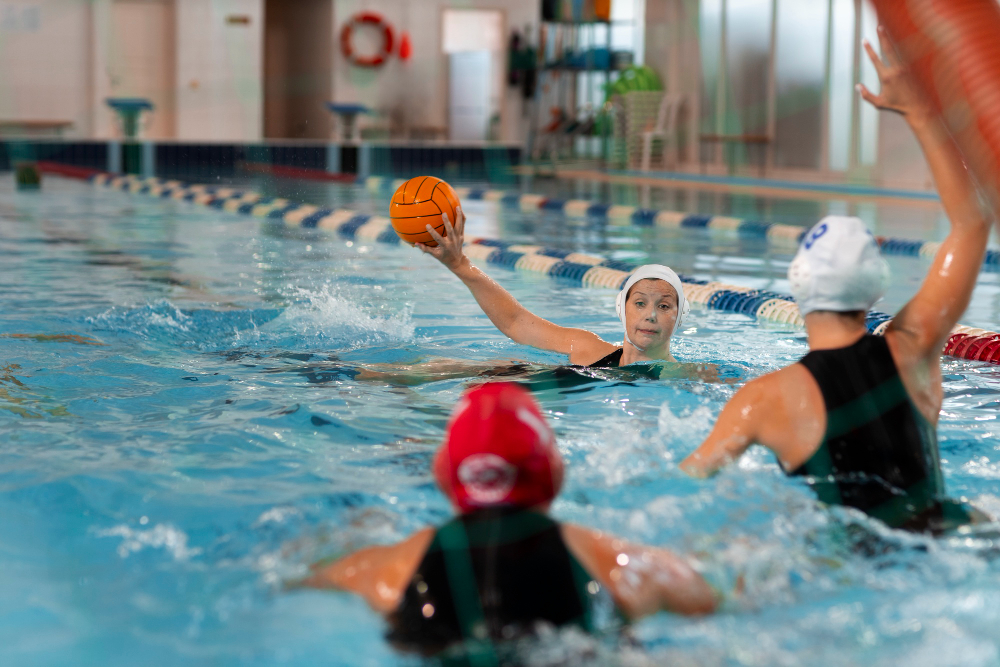Aquatherapy

Aquatherapy, also known as water therapy or aquatic therapy, involves performing therapeutic exercises and activities in a pool or aquatic environment under the guidance of a trained therapist. The buoyancy and resistance properties of water make it an ideal medium for rehabilitation and exercise, particularly for individuals with musculoskeletal, neurological, or orthopedic conditions. Aquatherapy can help improve strength, flexibility, balance, and overall functional abilities while minimizing stress on joints and tissues.
Benefits
Buoyancy: The buoyant force of water reduces the effects of gravity on the body, allowing individuals to exercise with less weight-bearing stress on joints, muscles, and bones.
Resistance: Water provides natural resistance to movement, requiring muscles to work harder and promoting strength and endurance gains.
Temperature: The warmth of the water can help relax muscles, alleviate pain, and improve circulation, enhancing the effectiveness of therapeutic exercises.
Balance and Coordination: The water’s supportive environment challenges balance and coordination, helping individuals improve proprioception and stability.
Reduced Risk of Injury: The low-impact nature of aquatherapy reduces the risk of injury, making it suitable for individuals with arthritis, joint pain, or mobility limitations.
Psychological Benefits: Aquatherapy promotes relaxation, reduces stress, and enhances mood, providing a therapeutic and enjoyable experience.
Techniques
Aquatic Exercises:
- Hydrotherapy Exercises: Range of motion exercises, stretching, and joint mobilization techniques performed in warm water to improve flexibility and reduce stiffness.
- Resistance Training: Using water resistance for strength training exercises such as leg lifts, arm curls, and trunk rotations.
- Aquatic Walking or Jogging: Walking or jogging in the water at varying depths to improve cardiovascular fitness, endurance, and gait mechanics.
- Swimming Techniques: Incorporating swimming strokes and techniques to enhance overall fitness and coordination.
Aquatic Bodywork:
- Watsu: A form of aquatic bodywork that combines elements of massage, stretching, and joint mobilization performed in warm water to promote relaxation and release tension.
- Ai Chi: A gentle form of aquatic exercise originating from Tai Chi, focusing on slow, flowing movements to improve balance, flexibility, and mindfulness.
Aquatic Therapy Equipment:
- Aquatic Noodles: Foam or inflatable noodles used for support and buoyancy during exercises and activities.
- Aquatic Weights: Water-resistant dumbbells or resistance bands used to add resistance to exercises and increase strength training benefits.
- Pool Steps or Ladders: Provides easy access to the pool and serves as a support for individuals during exercises and movements.
Considerations
Safety: Aquatherapy sessions should be supervised by trained therapists or instructors to ensure proper technique, monitoring, and safety precautions.
Individualized Approach: Aquatherapy programs should be tailored to each individual’s specific needs, abilities, and goals, taking into account their medical history and condition.
Progression: Aquatherapy exercises and activities should be gradually progressed in intensity, duration, and complexity as individuals improve their strength, mobility, and functional abilities.
Accessibility: Access to a suitable aquatic facility with warm water temperature, appropriate depth, and safety features is essential for conducting aquatherapy sessions effectively.
Aquatherapy offers a versatile and effective rehabilitation option for individuals with various physical and neurological conditions, providing a supportive and therapeutic environment for improving function, mobility, and quality of life. With proper guidance and supervision, aquatherapy can be an integral component of a comprehensive rehabilitation program, promoting recovery and well-being for individuals of all ages and abilities.


